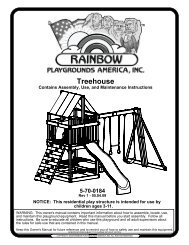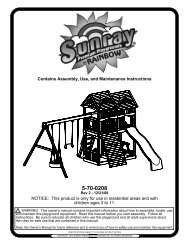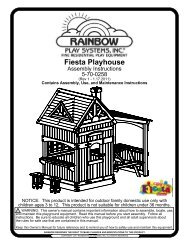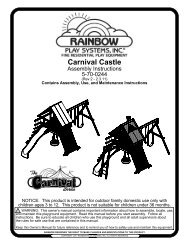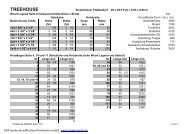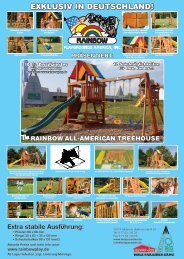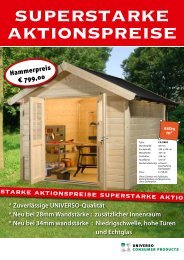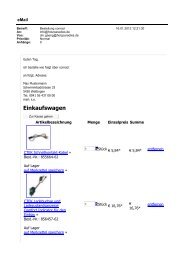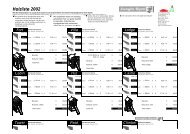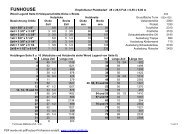Backyard Circus Club
Backyard Circus Club
Backyard Circus Club
Create successful ePaper yourself
Turn your PDF publications into a flip-book with our unique Google optimized e-Paper software.
Choosing a location for your play system<br />
When selecting your play site, always keep the child's safety in mind. Here are some recommendations that should help you achieve a safe<br />
play area.<br />
1. The play system should be located on solid level ground free of objects that could cause injury such as, but not limited to, tree stumps,<br />
roots, and large rocks. Stationary components such as ladders and slides must be no less than SIX FEET (1.8 meters) from any<br />
structure or obstruction such as a fence, garage, house, tree or overhanging branches, electrical wires or clotheslines. Any swinging<br />
equipment must be a minimum distance of TWICE the height of the swing beam away from any structures or obstructions as specified<br />
above. We also recommend that you do not install your play system near a lake, river, swimming pool or other water hazards.<br />
2. If anchoring your play system, all underground utilities must be located in play zone before starting assembly of play system.<br />
3. Try to locate slide out of direct sunlight to reduce the likelihood of serious burns. A slide that faces north will receive the least direct<br />
sunlight.<br />
4. It is recommended not to place a set on sandy soil or loose fill as it may require additional anchoring in that situation.<br />
5. Do not install your play system over concrete, asphalt, packed earth, grass, carpet, or any other hard surface. A fall onto a hard surface<br />
can result in serious injury to the play system user.<br />
Set Dimensions Play Zone<br />
L 15 1/2' x W 15' x<br />
H 11'<br />
L 27 1/2' x W 30 1/2'<br />
6' min.<br />
6' min. 6' min.<br />
6' min.<br />
2x Swing<br />
Beam Height<br />
2x Swing<br />
Beam Height<br />
Choosing a surfacing material<br />
The consumer shall provide playground surfacing materials under and around residential play equipment that conforms to the<br />
recommendations of the Consumer Product Safety Commission's Outdoor Home Playground Safety Handbook publications #324. A copy<br />
of the section relating to surfacing materials is included in the installation instructions. Free copies of this handbook are available on line at<br />
www.cpsc.gov or by contacting the CPSC Publications Office in Washington D.C. 20207.<br />
The URL is http://www.cpsc.gov/cpscpub/pubs/324.pdf and the file size is 456.5KB<br />
Playground equipment should never be placed on hard surfaces such as concrete or asphalt. Do not use loose fill surfacing on top of hard<br />
surfaces such as concrete or asphalt. While grass may appear to be acceptable, it may quickly turn to hard packed earth in areas of high<br />
traffic. Shredded bark mulch, wood chips, fine sand or fine gravel are considered to be acceptable shock absorbing surfaces when installed<br />
and maintained at a sufficient depth under and around playground equipment. The U.S. Product Safety Commission (CPSC) estimates that<br />
about 100,000 playground equipment-related injuries resulting from falls to the ground surface are treated annually in U.S. hospital's<br />
emergency rooms. Injuries involving this hazard pattern tend to be the most serious of all playground injuries, and have a potential to be<br />
fatal, particularly when the injury is to the head. The surface under and around playground equipment can be a major factor in determining<br />
the injury-causing potential of a fall. It is self evident that a fall onto a shock absorbing surface is less likely to cause a serious injury than a<br />
fall onto a hard surface.<br />
The following information is intended to assist in comparing the relative shock-absorbing properties of various materials. No particular<br />
material is recommended over another. However, each material is only effective when properly maintained. Materials should be checked<br />
periodically and replenished to maintain correct depth as determined necessary for your equipment. The choice of a material depends on<br />
the type and height of your playground equipment, the availability of the material in your area, and its cost.<br />
Table 3.1 lists the maximum height from which a child would not be expected to sustain a life-threatening head injury in a fall onto four<br />
different loose-fill surfacing materials if they are installed and maintained at depths of 6, 9, and 12 inches. However, it should be recognized<br />
that all injuries due to falls cannot be prevented no matter what surfacing material is used.<br />
3



